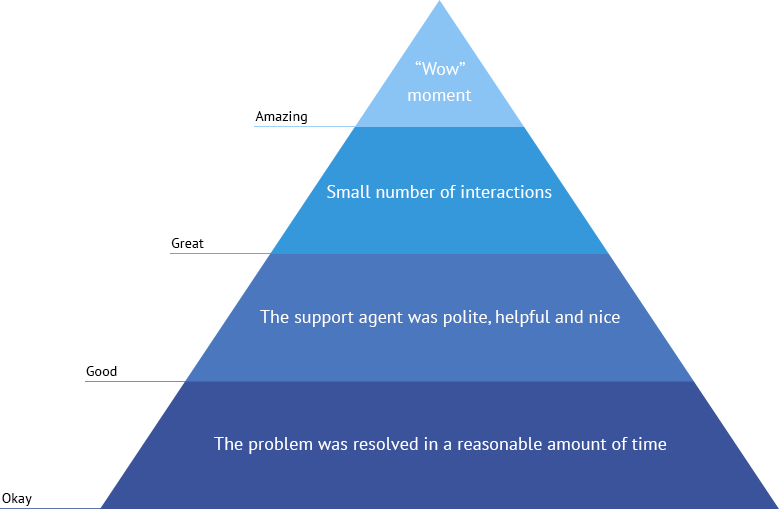Amazing customer support defined
 by Max Al Farakh ·
Apr 30 2014
by Max Al Farakh ·
Apr 30 2014
You probably already know that providing great customer support should be a top priority. What exactly an amazing customer support experience is? Over the years of answering support tickets and developing a helpdesk ticketing system, we figured out what works and what doesn’t and this is my attempt to give a definition of a “great customer support interaction”.
Customer support hierarchy of needs
Customer needs are represented as a pyramid on the following chart. I took the idea from Maslow’s hierarchy of needs. The idea is simple — if you can’t solve the problem, it doesn’t really matter if you were nice. The customer would still be upset. Of course, he is going to be less upset, since you were somewhat helpful and a pleasure to talk to. But the user’s fundamental need — solving the problem — hasn’t been satisfied.

Of course we are aiming at "amazing" here, but it’s not that easy and often - not possible at all. On the other hand, the "great" level is always achievable, so it should be the absolute minimum level of customer support you provide. It should always be “great” and sometimes "amazing". Let's take a quick look at each pyramid level.
The problem was resolved in a reasonable amount of time
Okay, this one is obvious — you have to actually solve the user’s problem. But what if you can’t? Let’s say, your product doesn’t support a feature the customer needs and you are not going to implement it. What can you do to earn some great-customer-support points?
Just say "no". Tell them you can’t help and provide a reasonable explanation. It may sound scary, but it works. We did this hundreds of times. It's OK to say "no". Users are always thankful that you’re being honest and not wasting their time. Of course, they will be upset, but at least they won’t be angry. Some companies are so afraid to say "no" that they keep pushing the customer's request down the queue to "deal with it later", which, in turn, sometimes results in not answering at all.
The support agent was polite, helpful and nice
This is really all there is to say. And it’s really self-explanatory. You have to be nice to people. In fact, you have to be the nicest person they ever met. Because people will remember this and they will tell their friends about this.
Small number of interactions
The problem should be resolved in as few interactions as possible. Ideally it should be resolved in just one single interaction, but you do not always have total control over it. Users rarely provide all the information you need to solve their issue right away. The best thing to do would be asking additional questions along with providing possible solutions.
Also, passing users around is a huge no-no. I mean, saying something like “Bob over at sales department handles this type of issues, contact him at bob@terrible-customer-support.com”. I’m sure there is a special place in hell for support agents who do this. You either contact Bob yourself and then pass the information to the customer OR you ask Bob to contact the customer himself.
The "Wow" moment
Up to this point everything was pretty simple. But getting to the amazing level is a challenge. First of all, what is a “wow” moment? Well, it’s something you do, that makes a customer say “WOW”. A huge burst of positive emotions he's going to remember. “Wow” moments have become the holy grail of customer support. It’s something you can’t always get, but should always be trying to.
This is a topic for another blog post and I won’t go much into details here. The “wow” happens when you go the extra mile. Just to give you an idea, here is a thing I like to do:
- A customer submits a new feature request or asks for a bug fix
- It’s an easy fix and it can be done in a couple of minutes
- I jump straight to the code, fix it and deploy the app.
- The customer gets his fix 10 minutes after submitting the ticket.
Works every time. So, keep your eyes open for opportunities like this.
You do not have to do anything special to provide great customer support: solve problems, be nice and don’t make customers do uncomfortable things. At the same time we should always seek for opportunities to be amazing. Go the extra mile and make customers say “WOW”.